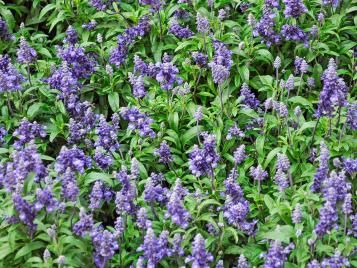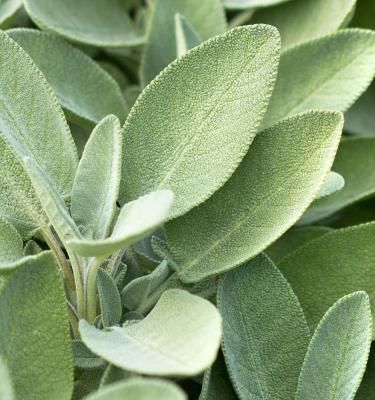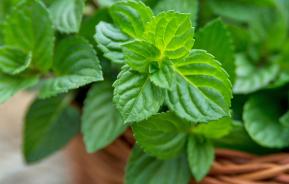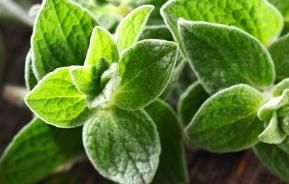Sage is a very popular shrub, mainly grown for its leaves, which are strongly scented. These are used as a herb in cooking to flavour many meat and vegetable dishes. Where would sage and onion stuffing be without the sage? The leaves are also used to make teas and tisanes.
Sage also produces masses of purple-blue flowers in summer that, along with the attractive grey-green foliage, make it a very ornamental evergreen/semi-evergreen shrub for beds, borders and pots.
How to grow sage
Cultivating sage
Sage prefers a warm, sheltered position in full sun, but will also grow well in light or dappled sage, although the flavour isn’t as strong. It needs a relatively fertile, moist, well-drained soil.
Sage varieties
The straight species, Salvia officinalis, is the one commonly grown as a herb. It is ornamental and attractive in its own right, thanks to its grey-green leaves and purple-blue flowers, but there are also some more ornamental varieties too. The foliage of these can be used in cooking, but it tends not to be as strong a flavour as the species.
Icterina Green and yellow variegated leaves.
Purpurascens Purple young foliage and stems, becoming grey-green as they age.
Tricolor Pink, white and green variegated leaves. Not as hardy as the common sage.
Broad-leaved sage Larger leaves and stronger flavour, making it an excellent culinary sage.

Planting sage
Planting is best done in spring or summer.
Dig a good sized planting hole, big enough to easily accommodate the rootball. Add a layer of organic matter – such as compost or planting compost – to the base of the hole and fork it in.
Place the rootball in the planting hole and adjust the planting depth so that it is planted at the same depth as it was originally growing (except hardy fuchsias) and the top of the roots are level with the soil surface.
Mix in more organic matter with the excavated soil and fill in the planting hole. Water in well, apply a granular general feed over the soil around the tree and add a 5-7.5cm (2-3in) deep mulch of well-rotted garden compost or bark chippings around the root area.
Where to plant sage
Plant sage in flower borders and beds, patios, containers, city and courtyard gardens, cottage and informal gardens.
How to care for sage
Sage is easy to grow and look after. It is fairly drought tolerant, but like all other drought-resisting plants needs watering until well established. Plants may also need watering during prolonged dry periods, but always avoid overwatering.
Avoid feeding with high-nitrogen feeds, which encourages soft growth, so use high potash ones instead, which encourage flowering, better flavours and strong, hardy growth.
You can care for sage plants by covering them with horticultural fleece in winter to protect the leaves from the worst of the weather and help keep them in good condition for picking. Protection with fleece may be a good idea in very cold and exposed areas.
Pruning sage
Plants can tend to become leggy in time, so it is important to prune them annually to keep them bushy and full of flowers Pruning after flowering helps to maintain a better, bushier shape and encourages plenty of new growth.
Sage does not shoot readily from old wood, so never prune old, brown, leafless stems – otherwise the plant will probably die. Old, neglected plants are best replaced. Annual pruning should help prevent this happening.
Harvesting sage
Leaves can be picked at any time, generally the younger leaves have the best flavour. Excess harvests can be dried or frozen. Freezing is the best option using leaves picked in mid-summer.
Sage flower petals look and taste great in salads.
Sage growing condition
| Flowering season(s) | Summer |
|---|---|
| Foliage season(s) | Spring, Summer, Autumn, Winter |
| Sunlight | Partial shade, Full sun |
| Soil type | Chalky, Loamy, Sandy |
| Soil pH | Neutral |
| Soil moisture | Moist but well-drained |
| Ultimate height | Up to 1.2m (4ft) depending on variety |
| Ultimate spread | Up to 1.4m (4ft) |
| Time to ultimate height | 5-7 years |








